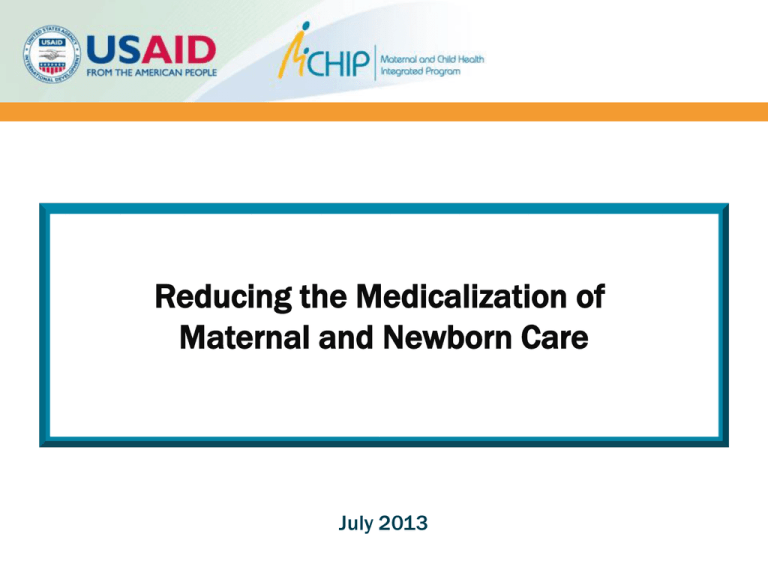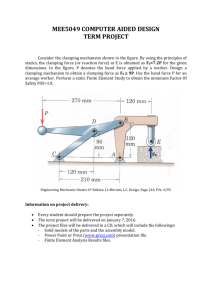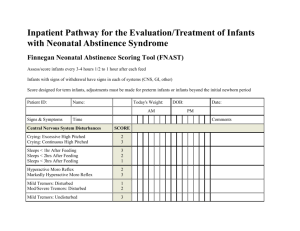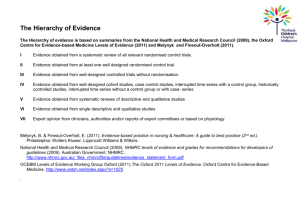Reducing the Medicalization of Maternal and Newborn Care
advertisement

Reducing the Medicalization of Maternal and Newborn Care July 2013 Session Objectives The objectives of this session are to: Introduce the concept of “medicalized” care Provide examples of maternal and newborn health (MNH) care practices that may be harmful or life-saving Provide examples of MNH care practices that are harmful Provide evidence to support the harmfulness of these examples 2 What is Medicalized MNH Care? The routine use of practices during labor and childbirth that: Are not evidence-based Are unnecessary or unwarranted Do not improve the health outcomes for mother or baby and may do harm Shift power from woman to provider Encourage technology or interventions without proven benefit 3 Symbols of a Medicalized Model: Technology The body as a machine Separation between the body and the mind Pregnancy is a medical condition that needs to be controlled 4 Symbols of a Medicalized Model: Centered on the Professional Care Giver Centered on the professional Disempowerment of the woman 5 Symbols of a Medicalized Model: Woman without Companion 6 Symbols of a Medicalized Model: Family Unit Separated During Labor & Delivery 7 Practices that May Be Harmful or Life-Saving Induction or augmentation of labor Cesarean section Episiotomy Restricting food and fluid Electronic fetal monitoring Routine nasal suctioning of newborn 8 Practices That Are Harmful Restricting ambulation/positions during labor and choice of birth position Lack of companion/family during labor Over-use of anesthesia/analgesia Separation of mother and baby Early cord clamping Routine enema or shaving 9 Unnecessary/Uncontrolled Labor Induction & Augmentation Labor induction has been associated with: More maternal interventions (epidural analgesia and cesarean section) Increased PPH Longer length of stay Higher likelihood of non-reassuring fetal heart rate tracings; need for neonatal resuscitation (Glantz 2010, 2012) 10 Unnecessary Cesarean Sections WHO standard is 5-15% Data from 137 countries: 54 countries had CS rates of ˂10%; 69 countries showed rates of ≥15%. Global saving by reduction of CS rates to 15% was ±$2.32 billion; the cost to attain 10% CS rate was $432 million. Overuse of global resources Local and national savings 11 (Gibbons 2012) Unnecessary C-Sections (cont.) Increasingly indications are subjective and non-clinical Data for 106,546 births found rate of cesarean delivery was positively associated with: Postpartum antibiotic treatment Severe maternal morbidity and mortality Increase in fetal mortality rates Increase in babies admitted to neonatal intensive care Rates of preterm delivery and neonatal mortality both rose at rates of C-S between 10% and 20% (Haberman 2013; Shah 2009; Boyle 2012; Villar 2006) 12 Unnecessary C-Sections (cont.) Detrimental to births following C-section Study: 10,684 women – 2,680 had prior C-S; 7,974 had prior VD Patients having a prior C-S: •had more than a 2.5-fold risk of requiring blood transfusion •had nearly a 4-fold higher risk of admission to the ICU •were 1.5 times more likely to be readmitted to the hospital than those with a prior VD (Galyean 2009) 13 Unnecessary/Routine Episiotomies Episiotomies can reduce maternal morbidity if they are restricted to specific indications rather than routinely RCT of 2,606 births in 8 maternities found: Anterior perineal trauma more common in the selective group Severe perineal trauma, perineal pain, healing complications, and dehiscence were all less frequent in the selective group In another study 14.3% of routine group had third- or fourth-degree perineal lacerations, compared to 6.8% in selective group (RR, 2.12; 95% confidence interval, 1.183.81) (Belizan 1993; Rodriquez 2008) 14 Restricting Food or Fluids in Labor Unproven fear of aspiration if oral intake allowed Allowing self-regulated intake of oral hydration and nutrition has been shown to help prevent ketosis and dehydration, and to reduce stress levels Cochrane review (3,130 women) found no justification for restricting oral fluid or food during labor (Bulletin of ACNM 2008, Singata 2012) 15 Restricting Ambulation & Choice of Birth Position Little data to show significant effect of positions on birth outcomes Choice of labor and birth positions encourages a woman’s sense of control Women who ambulated during the first stage of labor were less likely to have C-S, forceps or vacuum extraction (Albers, 1997) 16 Restricting Ambulation & Choice of Birth Position (cont.) Women who assumed a nonsupine position for birth had fewer perineal injuries (Shorten, 2002; Soong, 2005; Terry, 2006), less vulvar edema, and less blood loss (Terry, 2006) Women choosing nonsupine position for birth had shorter second stages, required less pain relief medication, and had fewer abnormal FHRs (Simkin 2002) 17 Unnecessary Electronic Fetal Monitoring Issues associated with using EFM: Technology, maintenance and costs Training – how to use, how to interpret High inter- and intra-observer variability in interpretation of FHR tracing (ACOG 2009) Lack of proven benefit of continuous EFM over intermittent auscultation in low-risk pregnancy (Cochrane 2013, ACOG 2009) May restrict ambulation and positions during labor 18 Unnecessary EFM (cont.) Continuous EFM vs. intermittent auscultation associated with: Increased rates of operative delivery (C-S, vacuum) With resulting increased risks to mother Reduction in neonatal seizures by 50%, but…. No reduction in neonatal death, cerebral palsy, other significant neonatal morbidity (Cochrane 2013, ACOG 2009) 19 Over-Use of Anesthesia/Analgesia Epidural/Intrathecal anesthesia is associated with increased rates of transient fetal heart rate abnormalities (even higher when intrathecal opioids/narcotics used) Newborns of women who receive intrathecal opioids/narcotics experience more difficulties initiating breastfeeding (Beilin, 2005; Jordan, 2005; Lieberman, 2002; Mardirosoff, 2002 Radzyminski, 2003, 2005) 20 Over-Use of Anesthesia/Analgesia (cont.) Compared with women using no pain medication or exclusively opioid pain medication during labor, women having epidurals have increased risk for: Longer first-stage labor (Alexander, 2002; Lieberman, 2002; Sharma, 2004) Longer second-stage labor (Alexander, 2002; Anim-Somuah, 2006; Feinstein, 2002; Lieberman, 2002; Liu, 2004; Sharma, 2004) Third- and fourth-degree tears associated with the increased incidence of instrumental vaginal deliveries (Lieberman, 2002) Fetal distress (Anim-Somuah, 2006; Liu, 2004) 21 Separation of Mother & Baby Eliminating or minimizing separation for procedures whenever possible reduces distress in healthy infants and mothers (Anderson, 2003; Gray, 2000; Klaus, 1998) Minimizing separation during the hospital stay increases breastfeeding initiation and duration in mothers with healthy infants (Anderson, 2003; Klaus, 1998) 22 Separation of Mother & Baby (cont.) Touching, holding, and caring for healthy, sick or premature infants or infants with congenital problems enhances attachment between mothers and babies (Charpak, 2001; DiMatteo, 1996; Feldman, 1999; Klaus, 1998; RoweMurray, 2001; Schroeder, 2006; Tessier, 1998) Eliminating or minimizing separation for procedures whenever possible reduces distress in sick or premature infants, infants with congenital problems, and mothers (Feldman, 1999; Klaus, 1998) 23 Unnecessary Nasal Suctioning of Newborn Literature search of 41 articles found no benefit from routine suctioning. Search found suctioning was associated with: perturbations in heart rate, apnea, and delays in achieving normal oxygen saturations. Based on the currently available literature, routine suctioning is more likely to cause harm than good Velaphi 2008 24 Early Cord Clamping – Term Infant Evidence has problems with definitions, i.e. “early” vs “late” In 11 trials of 2989 mothers and their babies, Cochrane review found: No significant differences for PPH (CI 0.96 to 1.55) Increased need in infants for phototherapy for jaundice (CI 0.38 to 0.92 in the late compared with early clamping group Increase in newborn haemoglobin levels in the late cord clamping group compared with early cord clamping (CI 0.28 to 4.06), although this effect did not persist past six months. Infant ferritin levels remained higher in the late clamping group than the early clamping group at six months McDonald 2008 25 Early Cord Clamping – Premature Infants In premature infants, Cochrane review found that early (within seconds) vs delayed (30-180 seconds) was associated with: fewer infants requiring transfusions for anaemia (RR 0.61, 95% confidence interval (CI) 0.46 to 0.81), less intraventricular haemorrhage (RR 0.59, 95% CI 0.41 to 0.85) lower risk for necrotising enterocolitis (RR 0.62, 95% CI 0.43 to 0.90) compared with immediate clamping Peak bilirubin concentration was higher for infants allocated to delayed cord clamping compared with immediate clamping (95% CI 5.62 to 24.40) Rabe 2012 26 Respectful Maternal & Newborn Care Respectful care demonstrates: Respect for a woman’s rights, choices, and dignity Care that “does no harm” 27 WE ALL HAVE A ROLE IN ASSURING THAT WOMEN HAVE RMC! THANKS!







